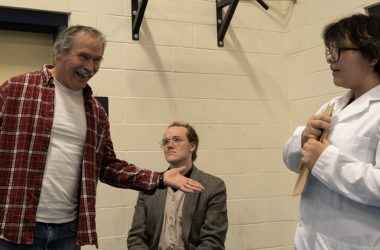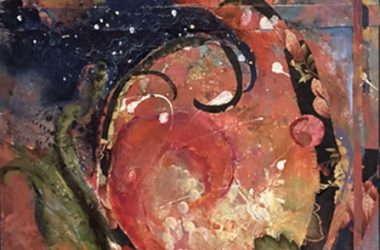GREENSBORO – Who would think that using an overhead projector, a projector sheet with hand-drawn stars and a magnifying glass, plus an eclipse would help explain Einstein’s Theory of Relativity? The upcoming total eclipse of the sun is generating lots of creativity including a play “When Light Bends,” which had its world premiere at the Highland Center for the Arts this past weekend. The play was an experience. The stage setting was minimalist but intriguing. A big shiny ball hung over the stage. Large nets streaking down from the top of the stage changed colors as the mood changed. A violin played behind the shrouded netting. It was a journey through space-time with Einstein and others as they figured out what makes matter move and how they themselves matter.
Three plot lines intertwine. One is about Albert Einstein and how he created the Theory of Relativity. We see him struggling to get his equations to function, grappling with his marriage, and the cast taking on Newtonian physics.
British astronomer Arthur Eddington who wanted to prove Einstein’s theory was featured in another plot. Eddington led an expedition to the Island of Principe to observe the solar eclipse of May 29, 1919. He was hoping to show how stars had moved from their normal positions because the light that could be seen during the totality of the eclipse was bending. This would be a proof of Einstein’s theory. In the play we are taught about relativity by the cast drawing diagrams and equations projected on a screen with an overhead projector, using magic, rope tricks, sleight of hand, even levitation and humor. This is a great way to teach science.
The third plot line takes place in our present. It follows Jen and Mer, two lovers who are climbing a mountain where they are going to watch the eclipse. We learn about their relationship and how the eclipse was part of a promise they made to each other.
The play is a creation of MAXlive, Media, Exploration and Arts whose mission “is to expand live performance through science and technology.” “When Light Bends” is based on an original concept by producer Kay Matschullat, directed by Elena Araoz, written by John Edgar Lopez and Gracie Leavitt. With their emphasis on science, and because they were dealing with the Theory of Relativity, astrophysicist Jared Goldberg joined the team. Justin Townsend designed the set and lights. Original music was composed by Tamar Muskal.
MAXlive is a New York City-based company which “specializes in breaking the boundaries of performance through incorporating science, music, and technology to envision a new path forward in live production.” (From program notes). This stage company certainly succeeded in making science and the theory of relativity accessible. I hope we get to see more of their productions.
Now when I look at the eclipse on April 8, (wearing my eclipse glasses), I will remember that the eclipse of 1919 helped solidify the new world view that Einstein’s theory brought and led scientists beyond Newtonian physics.
Lisa Sammet is the retired librarian of the Hardwick Jeudevine Memorial Library.






